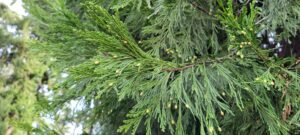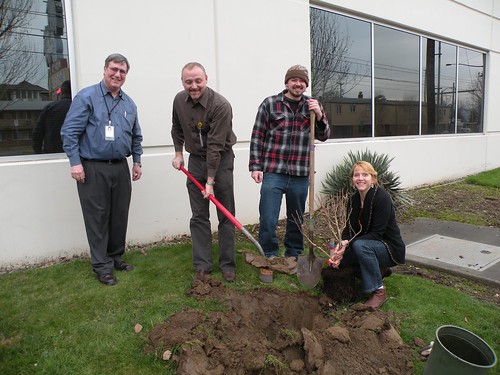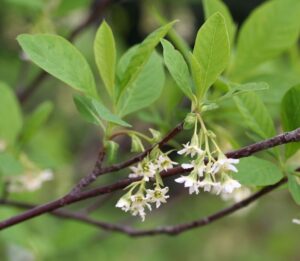Tag: flowering
Spring is coming! Or is it already here?
The Eugene Team shares their favorite signs of springtime
“Many buds are starting to swell,” Erik Burke says when asked when spring will arrive. “Witch-hazel, Persian ironwood and osoberry are all insect-pollinated woody plants that are blooming. Spring is here.”
The Eugene Director has always noted that the seasons aren’t evenly distributed in Western Oregon and Southwest Washington. “We have a short autumn, a relatively short winter, and long springs and summers. November is our wettest month on average, January is our coldest month, and while February can be cold, spring typically begins early in the month.”
Meteorologists observe March 1st as the first day of spring. Our calendars say March 19, the vernal equinox, when the days finally begin to be longer than the nights. But plants are on their own schedule.

“It’s a gradual roll out,” Erik says. We’ll see camas come out of the ground in December or early January as the incense cedar starts blooming. Filberts pollinate in January, and in February, we’re seeing willows leafing out, and daffodils and cottonwoods blooming.
“When the cottonwood buds drop on the bike path, it’s the best smell ever,” Erik says. “And in March, our native wildflowers are just beautiful.”
Some ecologists point to osoberry blooming as the first sign of spring, because it’s the first native insect-pollinated woody plant to bloom, and blooms with or just after the introduced witch-hazel and Persian ironwood.
“I love when the forest edges are covered in osoberry blooms,” says Taylor, our Eugene-Springfield Program Manager “I love that the days are getting longer faster. I love seeing the native bulbs lush and thriving.”

Spring is when we see the most pollen from the wind-pollinated trees that cause allergies. But luckily, it’s during the rainy season, and rain will knock a lot of those allergens out of the air. Incense cedar is the first to put out its pollen, followed by filbert, cottonwood, alder, birch, and hornbeam. Ash and oak follow in April.
Our early spring allows for most trees and plants to wrap up their reproductive processes by May, ahead of our annual summer drought. Until then, we get to enjoy the kaleidoscope of blooms in our canopy, across our hillsides, and in our own yards and gardens.
Century-old cherry trees bust a bloom

Steve Hendrix’s story in The Washington Post eloquently describes the original “geezer” cherry trees about to “bust a bloom” in Washington, D.C. You’ll love the photos, too. Below is an excerpt from the article:
In human years, they are 156 years old. And it shows.
You’ll seldom find a more gnarled, knobbed or bent-over bunch of geezer trees than these ancient Yoshino cherries lining a short stretch of the Tidal Basin. It’s an orchard of gnomes and trolls, a grove of exhausted old-timers boasting all the upright rigor of melted candles.
And yet, stand back. The “originals” are about to bust a bloom. For the 100th spring in a row, it’s showtime for the survivors of the first 3,000 Japanese cherry trees planted here a century ago this month.
Health and heartfelt contributions

More than a decade of planting trees at Kaiser Permanente’s Center for Health Research
By Jim Gersbach
Kaiser Permanente took the photo above and the photos in the slide show below at the latest ceremonial planting (February 11, 2011) that Kaiser Permanente does every year in conjunction with our hosting the Overlook neighborhood’s Friends of Trees Neighborhood Trees planting. We’ve done this for just over a decade and have 11 trees on the campus now that were planted in association with Friends of Trees.
For the past several years we have been planting hybrid Crape Myrtles in front of Kaiser Permanente’s Center for Health Research. They were chosen because they require heat to flower well, and this is a west-facing, sunny spot. Also, they fit the rather narrow space and will provide summer floral interest to people passing by on the MAX line.
It’s fitting that these trees are being planted on the grounds of a research center, since they came out of a successful U.S. Department of Agriculture research project to improve the hardiness and disease resistance of Crape Myrtles by collecting seeds from a rare Japanese species and making planned crossings.
–Gersbach is a volunteer Friends of Trees Crew Leader and Senior Communications Consultant for Kaiser Permanente.
Friends of Trees volunteers planted almost 160 trees in the Arbor Lodge and Overlook neighborhoods on January 29. The planting was sponsored by Adidas and Portland General Electric.
Many thanks to all of our volunteers and supporters, and to Kaiser Permanente for hosting Friends of Trees’ plantings in the Overlook neighborhood for many years. We also appreciate the Center for Health Research’s enhancement of health and education by planting trees on its campus for more than a decade.
High School volunteers help make Hazelwood, Centennial, Mill Park planting a huge success
By Kate Farrington
More trees than ever before were planted at the Hazelwood, Centennial, Mill Park planting on January 29, 2011. Neighborhood coordinators did a great job of getting the word out in the neighborhoods again this year and made it possible for us to plant 134 trees that Saturday. This number is up from 108 trees the year before and around 50 trees the year before that.
We never could have gotten them all in the ground without the help of local high school volunteers. A group of 10 students from Parkrose High School and around 30 English as a Second Language (ESL) students from David Douglas High School came out to plant that day and were a huge help. All their enthusiasm and energy were great to see out on planting crews. Thanks for all your help!
–Farrington is Neighborhood Trees Specialist for Friends of Trees.
The above slide show is made of photos taken by David Douglas High School ESL teacher Anne Downing. She and her student teacher, Tyler Green, arranged to have their students volunteer at Friends of Trees’ Martin Luther King Jr. Day of Service planting in the Lents and Powellhurst-Gilbert neighborhoods. Anne learned about that planting from Annette Mattson, who works at Portland General Electric, which sponsored the planting, and who has served for many years on the David Douglas School Board.
“The real value [of the plantings] is in the lifelong memories, pride in helping, and big smiles!” said Anne. “Did I mention fun? They (we!) had a blast!”
What’s Flowering Now? March 29


The Japanese Meteorological Agency announced last week that the cherry blossoms in Tokyo were in bloom, officially kicking off the viewing season.
For a society that has a phrase in its language (sakura zensen) describing the specific front of warmth that blooms cherry blossoms, this is no small announcement.
An excerpt from In Transit, a blog from The New York Times:
Japan designates specific cherry trees across the country for monitoring and considers a region to be in bloom when at least five or six flowers can be counted on each of that region’s trees. When 80 percent of the trees’ flowers have opened, typically a few days later, an area is officially designated as in ‘‘full bloom.’’
While Japan and Portland have already had their fill of cherry blossoms, the moment of fleeting beauty is still set to arrive in America’s capital.
With a time-line of April 1-4, the schedule of events is extensive for Washington D.C. and its famous Cherry Blossom Festival.
Here is an excerpt from an anecdotal Washington Post story about how one U.S. president felt about the cherry blossoms:
Franklin D. Roosevelt was mad.
This whole problem with the cherry blossoms was nothing but a “flimflam” cooked up by the newspapers to boost advertising, the president told the White House reporters.
“Six hundred trees” doomed, he mocked, reading from some headlines. “Public aroused,” he quoted, “Ten Million-Dollar Project.” It was baloney. As for those women chained to the trees down by the Tidal Basin . . . they would be carted off along with their trees.
Harsh words from FDR. But this was the great “Cherry Tree Rebellion,” as one newspaper called it — one of the strangest and most passionate chapters in the now-almost 100-year history of the cherry blossoms in Washington.
Here are links to previous editions of the Friends of Trees, ‘What’s Flowering Now?’ series: March 8; March 13; and March 22.
Submit your own photos of flowering trees to [email protected].
–Toshio Suzuki
What’s Flowering Now? March 22

By Greg Tudor
This lightly fragrant bloom—pictured last week at the Friends of Trees lot—will very slowly become a delicious fruit, most familiar in East Asia.
Offered for sale by Friends of Trees and its Neighborhood Trees program for yards and 6- to 8-foot parking strips, this Japanese cultivar introduced in 1972 requires a pollinator to bear fruit.
Of course, due to the difficulty of transporting the delicate fruit, it is not common in grocery stores.
Interested? Sign-up now for next season with Friends of Trees.
Submit your answers below or send in your own blooming photos and quiz.
–Tudor is the volunteer and outreach manager for Friends of Trees: 503-282-8846 ext. 12; [email protected]

